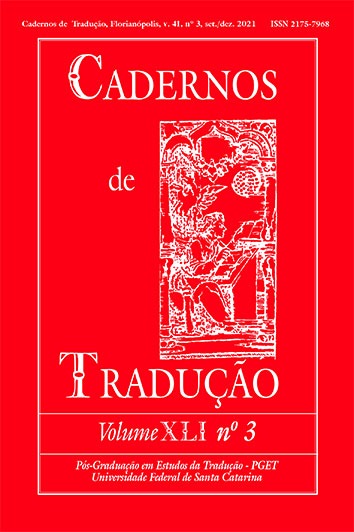“Everything Becomes Melody”: Remarks on Jenny Klabin Segall’s Versified Translation of Faust
DOI:
https://doi.org/10.5007/2175-7968.2021.e83252Keywords:
Alfabetização, Leitura-Estudo e ensino, Escrita-Estudo e ensino, Literacy, Reading-Study and teaching, Writing-study and teaching, Alfabetización, Letramento, Lectura, EscritaAbstract
The article analyzes the translation of Goethe's Faust by Jenny Klabin Segall regarding the verses used in the source text and in the target text. Considering the plurimetric structure of Faust and the differences between German and Portuguese prosody, the metric structure of several sections of the drama is analyzed, comparing Goethe's and the translator's decisions. It can be stated that the Portuguese verses are strictly oriented in the extension of the German verses, looking for metric ‘equivalents’ whenever this was possible (in the case of ottava rima stanza and alexandrine). It is concluded that, although there are no Portuguese meters that ‘imitate’ iambic or trochaic verses, the choice of pair verses for German iambs and impair for German trochees produces a differentiated rhythmic effect. For meters more divergent from Brazilian versification (Knittelvers, Freie Rhythmen), the translator found original solutions which draw near to the aesthetical effect of the original without transgressing the limits of Brazilian prosody.
References
Ali, Manuel Said. Versificação portuguesa. São Paulo: Edusp, 1999.
Alvarez, Beethoven. “A teoria do metro de Fabb & Halle e o decassílabo português”. Cadernos de Estudos Linguísticos, vol.56, 1, (2014). 141–180.
Attridge, D[erek]. “Rhythm”. The Princeton encyclopedia of poetry and poetics, Greene, Roland, et al. (orgs.). [Princeton]: Princeton University Press 2012. pp. 1195–1198.
Auer, Peter; Susanne Uhmann. “Silben- und akzentzählende Sprachen. Literaturüberblick und Diskussion.” Zeitschrift für Sprachwissenschaft, vol. 7, nº. 2, (1988): 214–59.
Boetius, Susanne. Die Wiedergeburt der griechischen Tragödie auf der Bühne des 19. Jahrhunderts. Berlin: de Gruyter, 2005.
Brogan, T. V. F. “Meter.” The New Princeton encyclopedia of poetry and poetics, edited by Alex Preminger and T. V. F. Brogan, Princeton University Press, 1993, pp. 768–83.
Bunia, Remigius. Metrik und Kulturpolitik. Verstheorie bei Opitz, Klopstock und Bürger in der europäischen Tradition. Berlin: Ripperger & Kremers, 2014.
Burdorf, Dieter. Einführung in die Gedichtanalyse. 3., aktualisierte und erweiterte Auflage, Verlag J.B. Metzler, 2015.
Cagliari, Luiz Carlos. “Línguas de ritmo silábico.” Revista de Estudos Linguísticos, vol. 20, nº. 2, (2012): 23-58.
Candido, Antonio. O estudo analítico do poema. São Paulo: Humanitas, 2006.
Chociay, Rogério. Teoria do verso, McGraw-Hill, 1974.
Ciupke, Markus. “Des Geklimpers vielverworrner Töne Rausch”. Die metrische Gestaltung in Goethes Faust. Göttingen Wallstein, 1994.
Eibl, Karl. Das monumentale Ich - Wege zu Goethes Faust. Frankfurt a.M.: Insel, 2000.
Esposito, Elena. Fiktion und Virtualität. Medien, Computer, Realität. Krämer, Sybille (org.). Frankfurt a.M.: Suhrkamp, 1998, pp. 269–296.
Frank, Armin Paul. “Versification and stanza formation: Towards a transfer approach.” Übersetzung - Translation - Traduction: 1. Teilband, Harald Kittel et al. (Ed.). Berlin: de Gruyter, 2004, pp. 963–980.
Goethe, Johann Wolfgang. Fausto. Uma tragedia. Primeira parte. Tradução de Jenny Klabin-Segall. São Paulo: Companhia Editora Nacional, s.a. [1943].
Goethe, Johann Wolfgang. Faust. Erich Trunz (Ed.). Hamburger Ausgabe in 14 Bänden, vol. 3, Dramen I). dtv, 1998.
Goethe, Johann Wolfgang. Fausto, Tradução de João Barrento. Lisboa: Relógio D’Água, 1999.
Goethe, Johann Wolfgang. Fausto. Uma tragédia. Primeira parte. Ed. bilíngue de Marcus Mazzari; tradução de Jenny Klabin-Segall. São Paulo: editora 34, 2004.
Goethe, Johann Wolfgang. Faust. Inszenierung von Peter Stein. (2000) 4 DVDs. Arles: Harmonia Mundi / Theater Edition, 2007.
Goethe, Johann Wolfgang. Fausto. Uma tragédia. Segunda parte. Ed. bilíngue de Marcus Mazzari; tradução de Jenny Klabin-Segall. São Paulo: Editora 34, 2007.
Goethe, Johann Wolfgang. “Drei Stücke vom Übersetzen – Três trechos da tradução.” Tradução de Roswitha Friesen Blume. Clássicos da teoria da tradução. Antologia Bilíngue: Volume 1. Alemão-Português, 2ª edição, revisada e ampliada. Werner Heidermann (Ed.). Florianópolis: Universidade Federal de Santa Catarina, 2010, 28–35.
Hartmann, Tina. Goethes Musiktheater. Singspiele, Opern, Festspiele, »Faust«. Berlin: de Gruyter, 2004.
Jakobson, Roman. “Linguistics and Poetics.” Sebeok, Thomas A. (org.) Style in Language. New York, London: Massachussetts Institute of Technology 1960: pp. 350-377; 435-449.
Kayser, Wolfgang. Kleine deutsche Versschule. Bern, München: Francke, 1986.
Küper, Christoph. Sprache und Metrum. Semiotik und Linguistik des Verses. Tübingen: Max Niemeyer, 2017.
Knapp, Fritz Peter. “Alle 600 Jahre kam der deutsche Geist sozusagen wieder dran”. Beiträge zur Geschichte der deutschen Sprache und Literatur, vol.137, 4, (2015): 599–622.
La D[riere[, J[ames] C[raig], and T. V. F. B[rogan]. “Prosody.” The Princeton Handbook of Poetic Terms, edited by Alex Preminger et al., Princeton University Press, 1986, pp. 218–23.
Lösener, Hans. Der Rhythmus in der Rede. Linguistische und literaturwissenschaftliche Aspekte des Sprachrhythmus, Niemeyer, 1999.
Massini-Cagliari, Gladis. “Três momentos da história da acentuação portuguesa.” Web-Revista Sociodialeto, vol. 4, no. 12, (2014): 555–74.
Moraes, João. “Intonation in Brazilian Portuguese”. Intonation Systems. A Survey of Twenty Languages. Hirst, Daniel; Di Cristo, Albert (orgs.). Cambridge: Cambridge University Press 1998. pp. 179–194.
Moritz, Karl Philipp. Versuch einer deutschen Prosodie, Berlin: Arnold Wever, 1786. http://db.saur.de/DLO/saveUrl.jsf?type=fullcitation&documentId=BDL02121_0001&volumeId=BDL02121_0001&user=fuberlin.
Reichmann, Tinka. “Frases célebres do Fausto: um desafio para a tradução.” Pandaemonium Germanicum. nº. 12, (2008): 191–209.
Schöne, Albrecht. Faust. Kommentarband. (Frankfurter Ausgabe, vol, I,7/ 2). Frankfurt a. M.: Deutscher Klassiker Verlag, 1994.
Schwitalla, Johannes. Gesprochenes Deutsch. Eine Einführung. 4., neu bearb. und erw. Aufl., Schmidt, 2012.
Trunz, Erich. “Kommentar”. Erich Trunz (Ed.) Faust. Goethes Werke (Hamburger Ausgabe in 14 Bänden, vol. 3, Dramen I). München: dtv, 1998.
Vennemann, Theo. Preference laws for syllable structure and the explanation of sound change. With special reference to German, Germanic, Italian, and Latin. Berlin, New York: Mouton de Gruyter, 1988.
Vennemann, Theo. “Der Zusammenbruch der Quantität im Spätmittelalter und sein Einfluß auf die Metrik.” Amsterdamer Beiträge zur Älteren Germanistik, vol. 42, (1995): 185–223.
Wagenknecht, Christian. Deutsche Metrik. Eine historische Einführung. 5., erweiterte Auflage. München: Beck, 2017.
Winslow, R. “Meter.” The Princeton encyclopedia of poetry and poetics, edited by Roland Greene et al., 4 ed. Princeton: Princeton University Press, 2012, pp. 872-876.
Downloads
Published
How to Cite
Issue
Section
License
Copyright (c) 2021 Cadernos de Tradução

This work is licensed under a Creative Commons Attribution 4.0 International License.
Copyright Notice
Authors hold the copyright and grant the journal the right for their articles' first publication, being their works simultaneously licensed under the Creative Commons Attribution License (CC BY), which allows the sharing of such works with its authorship acknowledged and its initial publication in this journal.
Authors are allowed to enter into separate additional contractual arrangements for the non-exclusive distribution of the journal's published version of the work (e.g., post it to an institutional repository or as a book chapter, with an acknowledgment of its initial publication in this journal).








































